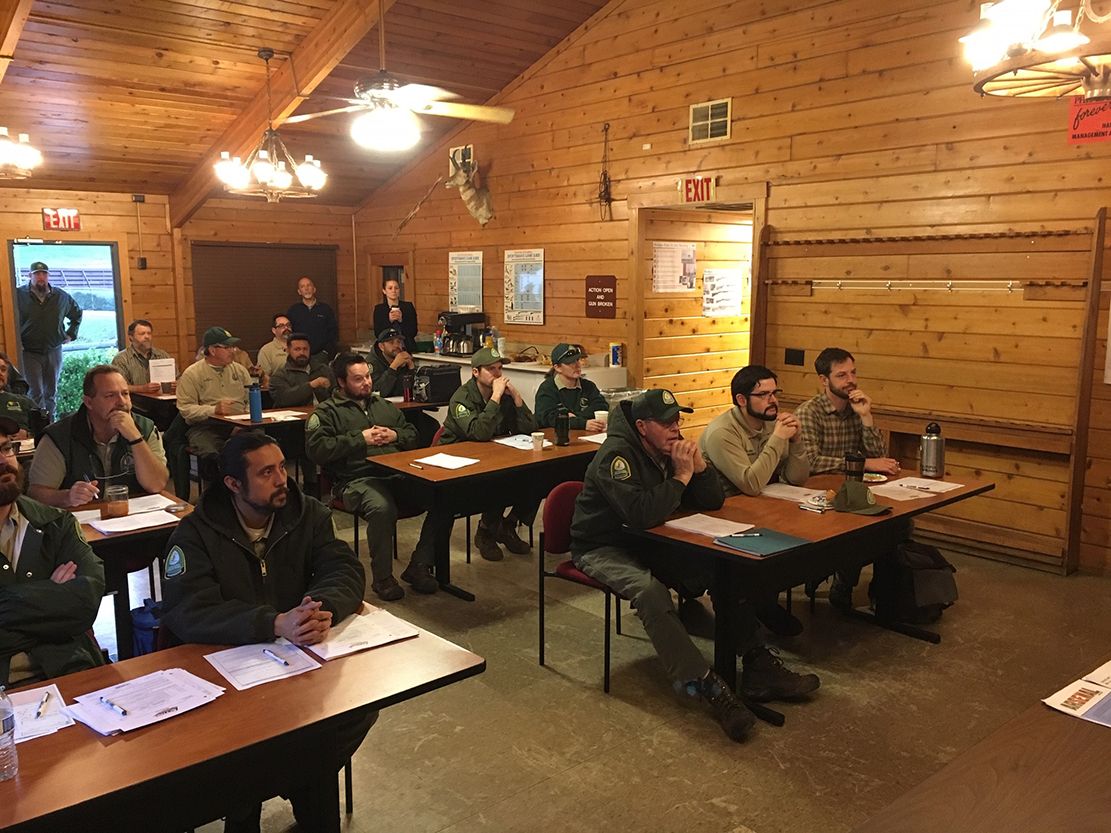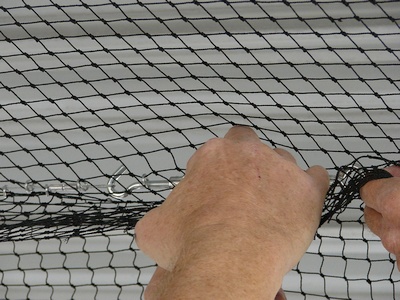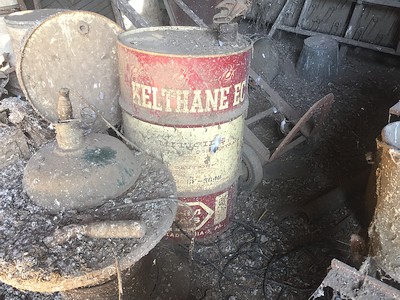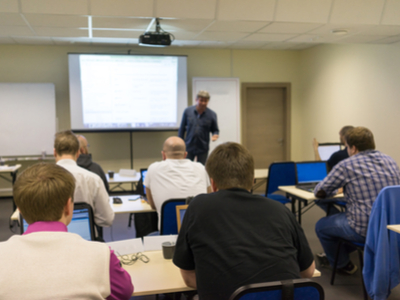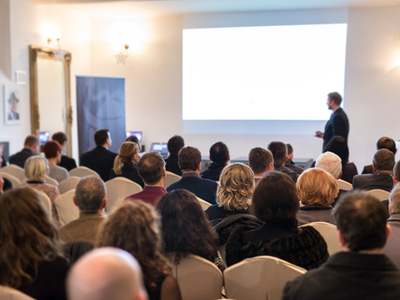Outreach Tools
Outreach in the field of IPM involves connecting with practitioners of pest management as well as their customers, such as policy makers, budget managers, and building occupants, who have the potential to influence the direction of product and service markets building occupants, who have the potential to influence the direction of product and service markets, addressing the interests of environmentally concerned citizens who support reducing the use of pesticides. A lack of awareness amongst policy makers, management, IPM practitioners, and the public about alternatives to pesticides is commonly cited as a challenge to pesticide reduction.
IPM events provide a unique opportunity to improve awareness and understanding of vents provide a unique opportunity to improve awareness and understanding of IPM practices. The practices. The urban IPM audience includes a diverse array of the non-agricultural public, such as the structural, turf and landscape industries, and their customers. Additionally, urban IPM addresses many non-traditional audiences such as health and environmental advocates, community groups, school children, indoor air quality professionals, physicians, and health and safety specialists.
Successful education and outreach programs are based on a solid understanding of the needs of the targeted audience and the use of appropriate techniques to disseminate the needed information. The following are examples of communication tools that can be used to generate education and awareness.
Planning and demonstrating reduced-risk pest management strategies should be a continuous process. Demonstrations and field trials on new innovative ideas, products and services are effective tools to train user groups. IPM demonstration sites helps to provide hands-on education coupled with a relevant, "real-world" example.
For example, Santa Clara County Department of Parks and Recreation has dedicated Ed Levin Regional Park to conduct field trials and demonstrations to evaluate reduced-risk chemical and alternative strategies.
Other County-owned sites are also used to conduct short-term trials. Over the course of the time that the IPM program has been functioning, several of these trials and demonstrations have been conducted. Alternative methods that have been proven effective and sustainable have been adopted at a wide scale and have become an integral part of current pest management, resulting in reduced use or elimination of pesticides.
- Aquatic weed control using mechanical harvesters
- Argentine ant control through precision baiting, physical alteration and tenant awareness
- Averting herbicide application in Turf through Field Scouting and decision-making process
- Biological Control of Algae in Lakes & Ponds and Rejuvenating water body using aerators
- Bird Exclusion at Correctional Facility
- California Ground Squirrel Control at Animal Shelter
- California Ground Squirrel Control at Correctional Facility
- California Ground Squirrel Control at Regional Airports & Regional Parks
- Dry Wood Termite Control: Inspection leading to decisions about fumigant use or non-chemical approach
- Norway Rat Control at Animal Shelter
- Optimizing Turf & Landscape maintenance protocols and Plant Health Care
- Pocket Gopher Control at Regional Airports
- Right of Way Vegetation Management - incorporating improvements in Road design through Poly pavement & Weed mats
- Total Vegetation Control on Roads (Rights of Way) - A decision making process
- Total Vegetation Control: using radiant heat and torches
- Total Vegetation Control: using Rubber, Wood Mulch, Weed Fabrics
- Total Vegetation Control: using solarization
- Total Vegetation Control: using steam - Waipuna Technology
- Total Vegetation Control: using Organic Herbicides
- Vermin proofing structures
- Yellow Jacket Abatement, Trapping & Control in Regional Parks
- Pesticide Applicator Safety Education Demonstration
Structural and non-agricultural use of pesticides represents a significant non-point source of environmental pollution of surface waters, ambient air and an unknown risk to these pesticide users. We know that the public, once reached, is interested in IPM and reducing pesticide risk. Universities and agencies rely heavily on the written word, and increasingly, the Web. While this information may be excellent, it never reaches most of the public. Also, written information on pesticides or IPM has traditionally not been geared to attract or hold the attention of the public. Until very recently, educational materials on pesticides or pests have been lacking. Reducing the pesticide load in the environment in urban areas will require a multi-faceted, long-term effort of public education and outreach.
"The public" represents a vast, diverse and diffuse audience. To reach these audiences with effective educational messages about reducing risk to the environment and to the self is the only mechanism for simultaneously reducing non-point source pollution and health risks. Planning education and outreach to such a diverse group will require identifying the under-served audiences through collaboration, networking and developing different types of partnerships.
Successful extension education outreach programs are based on a solid understanding of the needs of the targeted audience and the use of appropriate techniques to disseminate the needed information. One effective way is to partner with community groups, schools, businesses, agencies, and non-profit organizations to overcome obstacles and promote IPM education and implementation in schools and urban communities.
- Inner-city residents: the approach to this audience might include churches, community organizations, and other NGOs.
- Health care professionals: awareness training to this group has a role to play in spreading the reduced-risk message.
- Garden centers at point of purchase: the public often ask store workers about products for pest control, even though these workers may have no education. Educating this group will help to disseminate the message to hundreds of people every year.
- K-12 Children: working with school districts to include IPM curriculum will help at the grass roots level to capitalize on interests and get the message across.
IPM program staff are currently exploring these opportunities through networking with IPM Regional Alliance members, other organizations and industry.
Planning and demonstrating reduced-risk pest management strategies is a continuous process. The County IPM program staff, department IPM coordinators and department managers are always looking for grants and funding opportunities in this regard. As funds are made available, the process of demonstration and adoption of best management practices continues.
- An example of a successful community IPM outreach is the BugMobile, organized and hosted by the Pennsylvania state IPM program. An innovative educational experience, the BugMobile is a traveling educational attraction promoting the message of Integrated Pest Management (IPM) in a fun and exciting way. Ask the BugMobile questions and check out the IPM display with live insects, free educational materials, pest management information (weeds, diseases, wildlife, and insects), fun giveaways, and activities and games.
- A radio show organized by King County, discussed alternatives to weed and feed and the presence of pesticides in our waterways, while emphasized gardening with native plants to reduce pesticide use, reduce water use and restore habitat. The show was done live on location at Lowe's in Issaquah as part of Lowe's Going Organic promotion. King County supported the show as part of its Natural Yard Care program.
- Display: The Pest House: A handcrafted wooden dollhouse demonstrates a few pest problems: ten in fact. Flies, mold, ants, and raccoons are only some of them. Problems such as branches too close to the house and holes in walls can be rectified by moving a part that resets itself when the visitor is done. The display combines two over-arching concepts-pest problems and IPM solutions-into one exhibit. Visitors can interact with the house on three sides, one of which allows them inside the rooms.
- Display: Mosquito Pinball: Combine the thrill of learning ways to "fight the bite." A Mosquito Pinball game encourages visitors to earn points every time the ball comes in contact with a mosquito-thwarting practice, such as emptying sources of water, wearing repellent, encouraging natural predators, or cleaning gutters.
- Another example of an interactive community IPM outreach is the US EPA Environmental Kids Club, and Pollution Prevention Coloring Book, where environmental awareness is brought to the grass root level.
To reach target audiences with Extension IPM education publications, greater consideration should be given to the participant's background, perceptions of pest problems, current use of IPM practices, and preferences for educational formats. It varies with age group, day to day involvement of the participant in specific pest management activity who has diverse interest to know more about pests.
A few examples of the IPM related literature, brochures for the public:
Outreach Brochures
- Brochures by Our Water Our World
- A Good Bug Tub for Your Garden
- Building Occupants - Resolve chronic ant problems in your facilities
- Healthy Lawn Care
- Understanding and Managing Structural Ant Problems
- IPM Guidance Manual for the Facility Managers
- Stinging Arthropods Emergencies in Regional Parks
Other Publications
- Publications & Resources - Pennsylvania IPM Program
- IPM for Kids - Cool Websites with lots of interactive brochures, literature and games promoting IPM, engaging kids at the grass root level.
- Publications and other educational material by UC Statewide IPM Program
- Publications Related to Community IPM Awareness by NY State IPM Program
Public Service Announcements (PSAs) are short, "non-commercial" announcements prepared to provide information to the public. A non-commercial announcement contains information that benefits its intended audience, rather than the company that created it. For example, a PSA that provides IPM information differs from an ad that promotes the sale of a pest management product or service. Consequently, nonprofit associations produce most PSAs, but commercial, for-profit organizations may also use them to promote their nonprofit activities and events.
Free air time (usually 10- to 60-second spots) on television and radio is available to groups such as community associations, advocate groups, nonprofit organizations and for-profit organizations that are promoting their community, nonprofit events with PSAs. TV and radio stations donate this air time to meet the Federal Communications Commission's public service requirements.
PSAs are used by organizations to:
- Publicize community events.
- Provide health and safety tips.
- Assist in fund raising efforts.
- Inform and influence public opinion.
PSA messages:
- Must contain information that is beneficial to the community.
- Should not include controversial or self-serving material.
Many radio and TV stations have guidelines for acceptance and production of PSAs. Always send your news in their requested format.
Example of IPM PSA: "Heard us on the radio? We're running a series of public service announcements throughout New York that describe simple IPM techniques you can use in your home and yard to manage common pests." NY State IPM Program has developed series of PSA's to create community awareness towards IPM. You can hear the PSA or download the associated brochures for more information at NY State IPM Website.
SCC IPM Program is also working on the IPM PSA project. The PSA will be packaged with cover letter, storyboard and background information and pitched to the top 20 radio stations across the Bay Area. Periodic promotions will follow an initial mailing in pursuit of continued usage. These PSA will run throughout Santa Clara County that describe simple IPM techniques public can use in their home and yard to manage common pests.
The central lesson of urban IPM project implementation over the past decade is that the complex ecological and social context of IPM argues for a sustained effort combining elements of technological development, education, local organization, alliance building and lobbying.
Scientific excellence and adherence to ecological principles provide a strong technical basis for IPM development, and the application of participatory, non-formal adult education methods represent a real advance over models based on information dissemination and the delivery of simple messages. But these in themselves are not enough.
The long-term development of a sustainable IPM program also requires strong leadership and cooperation among user groups and the linkages between these groups and the wider community. The interactions of the people involved in a pest management system are the key to the success or failure of the program. When the respective roles of all the people in the pest management system are identified and agreed upon, and when these people communicate well with each other, effective and less expensive protection of the site and the people can be achieved with fewer risks.
Training is often identified as a major need or bottleneck in IPM projects, but uptake of lessons learned is often rather limited for various reasons. It can be argued that in some contexts, urban IPM requires a generally knowledge-intensive approach.
From this perspective, Santa Clara County's IPM trainings are not an end in themselves, but rather a good starting point for the development of a sustainable awareness among the public agency's user groups and the public at-large, enabling participants to design, implement and manage pest management plans beyond pesticides.
Training all employees on the basics of the County IPM policy, their department's IPM program, specific maintenance standards and IPM strategies will help ensure comprehension and consistency. Implementing the IPM approach from design through daily maintenance will eliminate unnecessary applications of chemicals. In addition, full implementation of a well-understood IPM approach will create a more efficient and safer environment, saving time and money and increasing worker safety.
All staff associated with the planning, design, construction, and maintenance of open space, parklands, roads, rights-of-way, parking lots, landscaped facilities and other areas where pests may need to be controlled should receive an orientation to the County IPM ordinance, their own department's specific IPM program, and these guidelines.
Department IPM coordinators, management groups, facility managers, procurement managers, policy analysts, public & environmental health managers, occupational safety managers, pest control contractors, gardeners and other ground maintenance workers for vegetation and/or other pest management activities should receive subject matter specific training on:
- An IPM overview, including: identification and life cycles of typical pests, weeds and beneficial insects; determining pest threshold levels for different types of landscapes and facilities; and pest monitoring techniques
- Noxious weed and other public-health pest identification, control, and regulations
- Pesticide laws and safety
- Specific best management practices as appropriate
- Pollution prevention, source control, hazardous material and waste management, green building concepts, eco-systems, watershed conservation, structural and landscape planning, etc
- Budget preparation
To reduce the potential for pesticide pollution from run-off and to conserve water, staff responsible for maintaining and scheduling irrigation systems should receive training on:
- Irrigation system maintenance and irrigation audits
- Scheduling based on evapotranspiration (ET) and seasonal fluctuations
- Backflow prevention
To the extent practical, IPM training should be shared across departments within an organization. This will minimize training costs and maximize outreach. Ideal training will also have on-the-job or field training components. Some subjects of interest are as follows:
- "I am the County IPM Guard" - An Administrative Training for Department IPM Coordinators, Facility Managers, Procurement Managers and Policy Makers
- "My Contribution to The Healthy Environment" - An IPM Awareness Training for Santa Clara County Employees (Sanitation, Housekeeping and Maintenance Awareness training)
- "Sanitation, Maintenance and Housekeeping - Role of Facility Managers and Building Occupants in Preventing Pest Problems" - This training is in a movie format, a collaborative effort of the County IPM Program and Orkin Exterminating Inc. The movie is available in VHS and DVD format, accompanied with "IPM Guidance Manual for the Facility Managers". The training through this media is capable of reaching all 16,000 county employees. We are also planning to disseminate the same to other interested public agencies and the pest control industry.
- "Kindergarten to K-12" - IPM Grass Root Campaign
- "The Bug that does not Bug Anymore" - Bug Safari
- "Rights-of-Way Pesticide Applicator Training" - Santa Clara County IPM Program has adopted this training manual as part of "SCC Annual Rights-of-way Pesticide Applicator Training". For more information please contact the County IPM Manager - [email protected].
- "Meeting the Experts" - Technical Training for Pest Managers, Subject matter specific training for various pest management projects
- "Reducing Risk Through Pesticide Safety and Education" - A training video designed (by UC Pesticide Education Program) for pesticide applicators to minimize self and environmental exposure to pesticides: The Pesticide Education Program strives to educate all pesticide applicators and users across the Santa Clara County about pest management alternatives, including the safe, proper, and legal use of pesticides. The program promotes responsible decision-making, which will protect pesticide users, public health, plant and animal health, and the environment. (The 109-page Reducing Pesticide Risks instructor's manual (PDF 2782K) is designed to be used with this video. Copies of this public-domain video are available from each state pesticide regulatory agency and from Cooperative Extension Service pesticide applicator training coordinators). This training video is currently in use by SCC IPM Program as part of "Annual Pesticide Applicator Safety Education (IPM-PASE)" for pest control license holders, pest control maintenance workers and management staff in Department of Roads & Airport, FAF custodial and grounds staff and Department of Parks & Recreation. The California Department of Pesticide Regulation - Pest Management and Licensing branch has assigned 7 hours of continuing education units (CEU) to SCC IPM-PASE training. The training also meets State-mandated training requirements. For more information please contact the County IPM manager - [email protected].
- "Regional IPM Conference" and "Regional IPM Resource Manual" - Lack of training is often cited as an obstacle to the wider adoption of IPM methods, where each individual has to understand their role and participates to promote pest prevention and minimize pesticide use. Establishment of a collaborative IPM training program and conference, inclusive of several public agencies, organizations and industry has been a long-term goal of the program. A collaborative approach among participating public agencies in the Bay Area is designed to enable participants to develop and implement pest management plans beyond pesticide applications in their respective jurisdictions and to provide public education and outreach at a broader horizon. Santa Clara County has taken a leadership role in forming the IPM Regional Alliance.
The first ever-Regional IPM Conference was hosted by Santa Clara County held on June 7, 2004 at the 70 West Hedding Street, San Jose, CA. The County IPM program was also successful in compiling and editing the first "Regional IPM Resource Manual". Approximately five hundred (500) copies were developed and distributed to the participants and other interested parties. Bio-Integral Resource Center, a non-profit organization and the co-author of the "Regional IPM Resource Manual", has requested to distribute this version through their IPM publication department. The proceeds will help their organization to further assist in improving and updating the manual as and when needed. - "Precautionary Principles for Pollution Prevention" - A training module designed for policy makers and executive management, this training module provides an in-depth look on understanding environmental policy development and management, precautionary principles towards environmental stewardship, budget preparation, program/portfolio consolidation, grant and fund management, environmentally preferable purchasing, green building concepts, organic gardening, resource conservation, etc.

